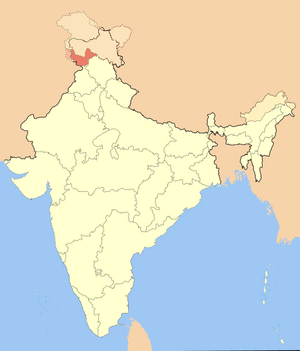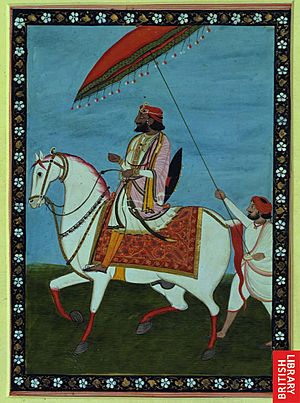Jammu region facts for kids
Quick facts for kids
Jammu Region
|
|
|---|---|
|
State division
|
|

Bagh-e-Bagh and Bagh Lake
|
|

Map of Jammu division within Indian Kashmir, disputed territory
|
|
| Country | |
| State | Jammu and Kashmir |
| Districts | Doda, Jammu, Kathua, Poonch, Rajouri, Udhampur |
| Headquarters | Jammu |
| Area | |
| • Total | 26,293 km2 (10,152 sq mi) |
| Population | |
| • Total | 6,907,622 |
| • Density | 262.717/km2 (680.434/sq mi) |
| Demonym(s) | Kashmiri, Koshur (in Kashmiri) |
| Languages | |
| • Official, Main spoken language | Urdu Kashmiri |
| Time zone | UTC+5:30 (IST) |
Jammu is one of the three main parts of Jammu and Kashmir in northern India. This area is mostly hilly and mountainous. It includes the Pir Panjal Range, which separates it from the Kashmir Valley. The eastern districts of Doda and Kishtwar are part of the Great Himalayas. The main river flowing through Jammu is the Chenab. The Chenab Valley is also an important area in the Jammu region.
Jammu city is the biggest city in the Jammu region. It is also the winter capital of Jammu and Kashmir. People call it the "City of Temples" because it has many temples and shrines. Their tall, shining shikhars (spires) reach into the sky. This makes the city feel very holy and peaceful.
Jammu is a major pilgrimage (religious journey) center for Hindus. It is home to famous Hindu shrines like Vaishno Devi. Most people in Jammu practice Hinduism. However, Islam and Sikhism also have a strong cultural presence here. Jammu has good facilities and has become the main economic hub of the state.
About Jammu Region

Jammu city was traditionally the center of power for the Dogra rulers. It is the second-largest city in the territory. More than two-thirds of the people in Jammu are Kashmiri Hindus. Most of them live in the southeastern part of the Kashmir region. They are closely related to the Punjabi-speaking people in the Punjab region of India and Pakistan. Many people in Jammu speak the Dogri language. Most of the state's Kashmiri Sikhs also live in the Jammu region.
As you go northwest, the number of Muslims increases. Muslims form a large majority around the western town of Poonch District. Jammu is the only region in Kashmir with a Hindu majority. Islam and Sikhism have strong cultural ties with neighboring Punjab (Pakistan). Most Hindus are either Dogras or people who moved from Kotli, Mirpur, and the Kashmir Valley. The Sikhs are originally from Punjab. Jammu is well connected to the rest of India by train, road, and air. This makes it easier to reach than other parts of the Kashmiri region.
Fun Places to Visit
Jammu is famous for its beautiful scenery and old temples. It has many Hindu shrines. You can also visit the Mubarak Mandi Palace and the Amar Mahal Palace. The Amar Mahal Palace is like a castle and is now a museum. There are also lovely gardens and strong forts.
Hindu holy shrines like Amarnath and Vaishno Devi attract thousands of Hindu visitors every year. Jammu's amazing natural beauty makes it a top spot for adventure tourism in South Asia. Jammu's old buildings show a special mix of Islamic and Hindu building styles.
Images for kids
-
Kashmir region divided across Pakistan, India and China (map by CIA)
See also
 In Spanish: División de Jammu para niños
In Spanish: División de Jammu para niños









